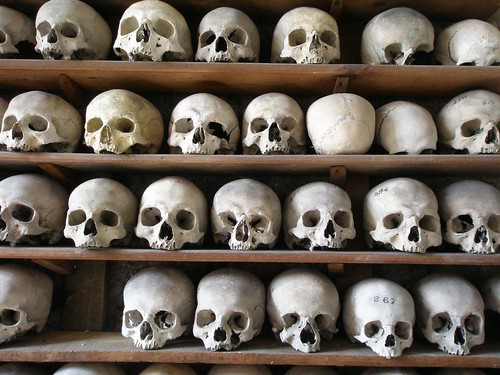In the company of Anne Ward, author of the Nothing to See Here blog and book, we pay a visit to a huge pile of bones.
The crypt of St Leonard’s Church in Hythe contains one of only two ossuaries in the UK (the other is in Rothwell, Northants). It holds over 2,000 skulls arranged neatly along the walls and 8,000 bones in a huge pile stacked almost to the ceiling – like a macabre game of Jenga. When death is such a taboo these days it’s a shock to see so much of it staring you in the face.
Seeing so many skulls in one go makes them less of a sinister object and more of an anthropological souvenir. They come in all shapes and sizes, some with axe wounds and congenital deformities – a sign of the times. One even shows a trepanning wound, where a hole was drilled in the skull and miraculously, the patient survived. A table of jawbones shows rows of teeth in surprisingly good shape. In those days refined sugar wasn’t part of the diet and the greatest dental hazard was tough bread.
This collection is gold dust for those want to know more about the health and genetic make-up of our predecessors. The numbers stamped on to each skull are signs of a study that took place in the 1930s. When I visited, a forensic anthropology student from Bournemouth University was working away with a craniometer, measuring the skulls one by one. The owners hope that new technology will reveal more about the lives of the people who came to rest here.
There have been many theories about how such a large collection got here – as the result of a Saxon battle or a wave of the Black Death. The mostly likely explanation is less dramatic, simply that an existing burial ground was disturbed during the building of the new church in the 13th Century.
At that time ossuaries were relatively commonplace. Bodies were only buried for a short while before being dug up again. The skulls and femurs (thigh bones) were kept as they were the two strongest bones and it was thought that their preservation was enough to guarantee passage into the afterlife. This might seem horribly disrespectful by today’s standards but it was a sign that the physical body wasn’t important. The soul had already ascended to heaven and so the body returned to dust.
In olden times Hythe was a bustling place, the middle of five Cinque Ports between Hastings and New Romney to the west and Dover and Sandwich to the east. King Edward established the Cinque Ports in 1155 and let these towns keep legal fees from court cases in return for providing ships and sailors when the Crown needed them. The increased income and improved trade links made these towns much more profitable than their neighbours. The size of St Leonard’s, a substantial church in a relatively small town gives some indication of Hythe’s prosperity.
The arrangement of the bones and the design of the crypt indicate that the bone house was an ‘ambulatory’ where priests would parade a holy relic of St Leonard and pilgrims could walk round to pay their respects. As a busy port, Hythe was well-placed to attract visitors on their way to or from Canterbury Cathedral and the few groats collected would have been a steady money-spinner. Today, health and safety regulations have put paid to group visits but the ossuary is open most days. For a small donation visitors of any denomination can also look and wonder at this awe-inspiring spectacle.
[More photos here]









How interesting that we have an example of this foreign practice on our shores. I recommend clicking on the link above to the further photos as they are quite impressive
The mostly likely explanation is less dramatic, simply that an existing burial ground was disturbed during the building of the new church in the 13th Century. This is what happened at that big ticket item in the world of skeletons, the Paris catacombs, they were running out of room, the Parisians so up came dem bones and down the old workings they went. Strange place, ten minutes in and a surfeit of skulls rears it’s head, funny entrance, odder exit.
The graveyard of Linton Kirk, in the Borders, near Morebattle, has for many years had a collection of bones protruding from the soil, due to soil erosion, the Kirk is on a mound. Some unkind wag has pointed out that there is no cause for alarm, the bones are from the sheep, stolen in Northumberland by the Scottish Reivers and held in the pele towers, as sex slaves.
Well worth a visit – it’s an experience that I reckon will leave an impression. I wrote about my own trip there on the old blog:
http://gawragbag.blogspot.co.uk/2009/10/ossuary.html
I can also recommend a visit to Rome’s Capuchin Crypt, or just got to any contemporary art/craft or design exhibition for your fill of skulls.